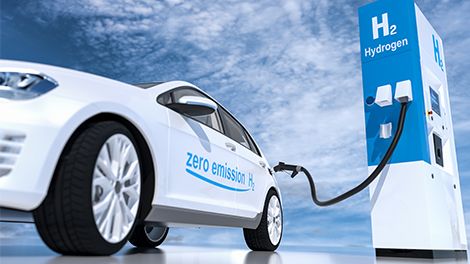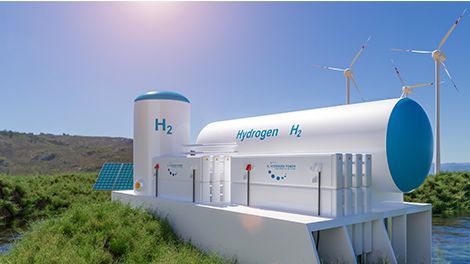Using hydrogen: What does a fuel cell do?
A fuel cell is needed to convert hydrogen (H2) into electricity; strictly speaking, this is a hydrogen-oxygen fuel cell. It is also often referred to simply as a "hydrogen fuel cell". In the following, "fuel cell" and "hydrogen fuel cell" are used synonymously. In hydrogen fuel cells, hydrogen serves as the fuel and oxygen (O2) as the oxidant. By converting chemical energy directly into electrical energy and heat, hydrogen fuel cells have significantly higher efficiencies than conventional power plants.
In combination with a fuel storage system and hydrogen recycling, fuel cell systems enable pollution-free energy generation. The power spectrum of hydrogen fuel cells ranges from the sub-kW range of individual cells to the MW range in the form of virtual power plants. The field of application of hydrogen fuel cells ranges from heat and power supply in buildings to off-grid applications and the propulsion of vehicles, aeroplanes and ships. Fuel cells have increasingly come into focus, especially due to the discussions about the role of hydrogen in e-mobility.
Fuel cell: function and design
How does a fuel cell work and how is it designed? A fuel cell consists of a network of several cells that are separated by separators and arranged in a stack. The structure of a fuel cell is planar in layers or, in the case of solid oxide fuel cells, tubular as a tube system. Electrolysis plays a decisive role in the functioning of fuel cells: the core of an individual fuel cell is formed by a liquid or solid electrolyte, which is enclosed on both sides by bipolar electrode plates (anode and cathode).
These plates have a porous diffusion layer (GDL - gas diffusion layer), which guides the reaction gases over a precious metal-coated catalyst surface (low and medium temperature range) or over a catalyst made of nickel, ceramic or steel (high temperature range). This is how, in most fuel cell types, the hydrogen is split on the anode side and the electrons are discharged to the electrical consumer. The hydrogen protons migrate through the electrolyte to the cathode side, where they combine with the added oxygen to form water (H2O).
Fuel cell efficiency
Fuel cells use hydrogen to generate electricity. The hydrogen drive in a fuel cell vehicle is a well-known example: the electricity from the fuel cell drives corresponding vehicles, with only emission-free water vapour ultimately being emitted from the exhaust. Currently, the efficiency of a fuel cell is about 60 %. This technology should not be confused with that of a hydrogen engine, which is a hydrogen combustion engine.
For comparison: electrolysis has an efficiency of 60 to 70 %. A modern petrol engine or gasoline engine has an efficiency of about 24 %, whereas diesel engines are able to use about 40 % of the energy stored in the fuel. Aircraft engines also achieve similar efficiencies to vehicle engines, depending on the quality of the engine. Thus, there is much to be said for the use of fuel cells in vehicles that have to travel longer distances and move heavier loads every day.
Hydrogen is a topic with many facets - from production, transport and storage to use. With our expertise, know-how and many years of experience, we are an independent partner for safety and security by being able to test, inspect and certify various aspects of hydrogen technology.
Types of fuel cells
Six different types of hydrogen fuel cells are currently in use. These fuel cell types convert different gases into electricity, use different electrolytes and are classified as low, medium or high temperature fuel cells depending on their operating temperature. The individual fuel cell types are specifically assigned to the following categories:
- Low temperature fuel cells: Alkaline fuel cell, membrane fuel cell, direct methanol fuel cell
- Medium and high temperature fuel cells: Phosphoric acid fuel cell, molten carbonate fuel cell, solid oxide fuel cell.
The range of applications for hydrogen fuel cells is large and growing constantly, as they are reliable in operation, low-maintenance and environmentally friendly. While all types of fuel cells are suitable for stationary applications, mainly low-temperature fuel cells are used in portable and mobile applications.
|
AFC – Alkaline Fuel Cell
This type of fuel cell, which belongs to the low-temperature fuel cells, set a milestone in the development of fuel cell technology. The alkaline fuel cell was particularly successful in space travel and in powering submarines. The world's first fuel cell passenger boat was also powered by alkaline fuel cells. Despite its robust system, this type of fuel cell has a relatively short lifetime. The alkaline fuel cell does not achieve the high power density of today's widely used membrane fuel cells or PEM fuel cells.
PEMFC – Proton Exchange Membrane Fuel Cell
No other fuel cell type can be used in as many ways as the membrane fuel cell or PEM fuel cell. Due to the high dynamics of the power output, PEM fuel cells are often used in the mobile sector, e.g. in cars, vans and buses, but also for applications in aviation, space travel and shipping. A wide field of application for PEM fuel cells, which belong to the low-temperature fuel cells, is the emergency power supply, for example in rail transport and telecommunications, as well as the protection of critical industrial infrastructures or data centres.
Smaller fuel cell systems are used, for example, in portable generators or stationary in the area of domestic energy supply through combined heat and power plants. Larger systems of PEM fuel cells can be found, for example, in hospitals, public swimming pools or other municipal supply facilities. Currently, the PEM fuel cell has the greatest potential of all types of fuel cells, especially in terms of mass production.
DMFC – Direct Methanol Fuel Cell
Thanks to their straightforward handling, direct methanol fuel cells are widely used. In stationary applications, direct methanol fuel cells are used for off-grid power supply of measuring stations, monitoring systems or communication equipment. Direct methanol fuel cells are used as portables, e.g. in the leisure sector, and often as range extenders for electric vehicles. But what are the advantages and disadvantages of the direct methanol fuel cell? First of all, the advantages: With its high storage density, the direct methanol fuel cell enables electric vehicles to have a long, environmentally friendly range. Moreover, the reaction of methanol (CH4O) with oxygen in direct methanol fuel cells produces only a small amount of carbon dioxide (CO2) in addition to water vapour. Moreover, liquid methanol can be easily stored.
With regard to the disadvantages of the direct methanol fuel cell, it should be noted above all that methanol is not only corrosive, but also extremely toxic. Therefore, the highest safety regulations must apply during storage. Due to the working temperatures of up to 120 °C, sufficient cooling must also be ensured. Since a portion of the methanol migrates from the anode to the cathode, the direct methanol fuel cell also has only a low electrical efficiency. Another disadvantage of the direct methanol fuel cell is that carbon dioxide is produced in the cell during cold combustion.
PAFC – Phosphoric Acid Fuel Cell
As a medium-temperature fuel cell, this type of cell not only has a higher operating temperature than low-temperature fuel cells, but also a certain tolerance to carbon monoxide (CO) and carbon dioxide, so that it can be operated primarily with reformed natural gas. However, due to its acidic, aggressive electrolyte, it also has a comparatively short lifetime. It is used in the field of combined heat and power generation, e.g. in stationary energy supply for industrial plants, shopping centres, hospitals or even housing estates.
MCFC – Molten Carbonate Fuel Cell
As a high-temperature fuel cell, the molten carbonate fuel cell has the advantage of being insensitive to carbon monoxide and of being able to use natural gas, coal, biogas and synthesis gas directly without the process of reforming. However, the internal carbon dioxide cycle of the molten carbonate fuel cell requires additional electrolyte and carbon dioxide management. As with the medium-temperature fuel cell, the molten carbonate fuel cell prioritizes heat production over electricity production. Since it has a longer start-up phase and its lifetime is largely determined by the number of start-stop cycles, the molten carbonate fuel cell ideally operates in base load mode in power plants and CHP plants.
SOFC – Solid Oxide Fuel Cell
Compared to the molten carbonate fuel cell, the solid oxide fuel cell is characterized by a comparatively simple system, a long lifetime and high efficiencies. The operating temperature of solid oxide fuel cells of up to 1,000 °C qualifies these high-performance, high-temperature fuel cells for the extraction of process heat and thus for stationary use in power stations and combined heat and power plants, but also for heating systems in detached and semi-detached houses. In combination with gas turbines, molten carbonate fuel cells are also used in smaller combined heat and power plants and large-scale power generation plants.



